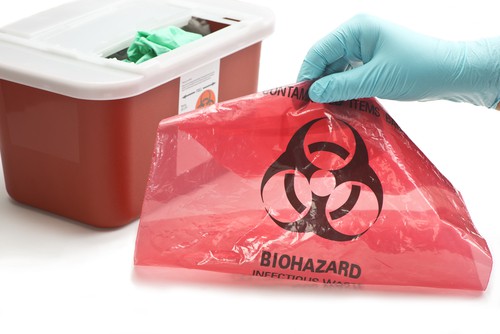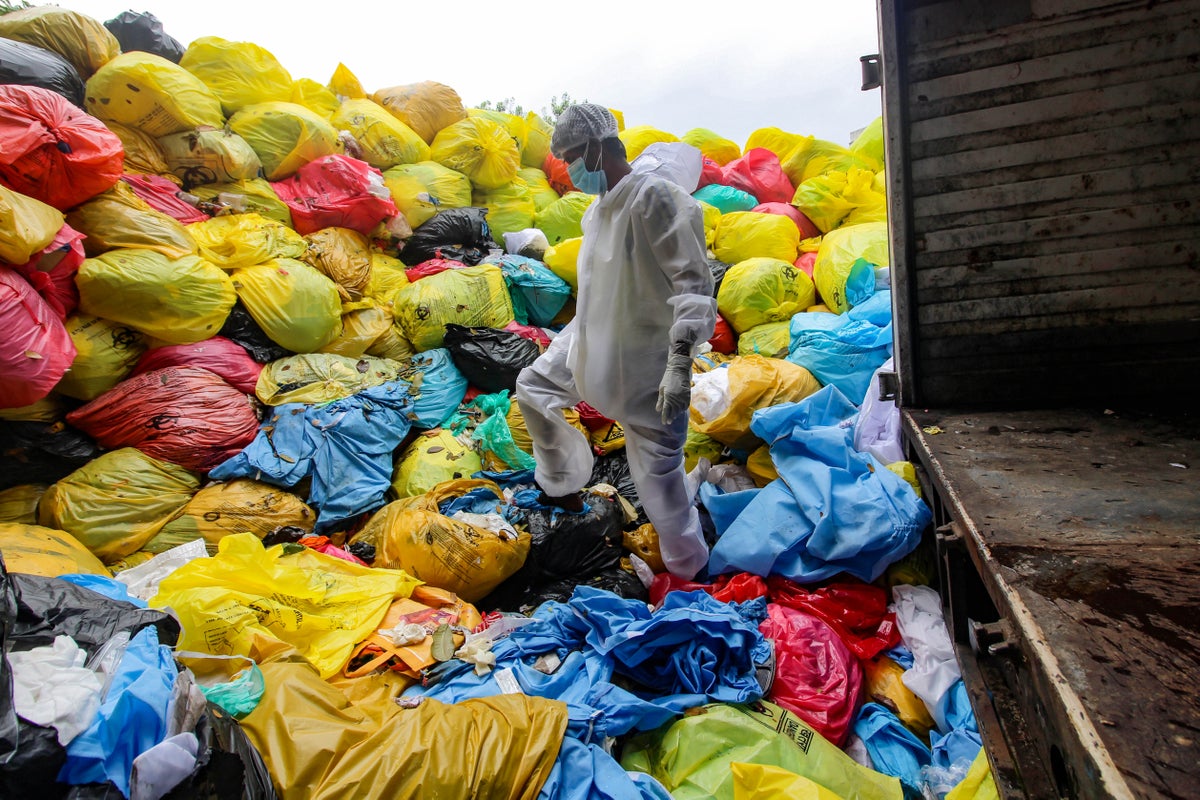Your Ally in Medical Waste Removal: Specialist Service with Environmental Care
Wiki Article
Ideal Practices for Medical Waste Administration
Clinical waste monitoring is a critical facet of health care centers' operations to make sure the security of people, staff, and the atmosphere. Implementing ideal practices in medical waste administration is essential to reduce the threats connected with contaminated materials. This includes appropriate segregation and categorization of waste, ensuring its secure storage and labeling, adhering to regulative standards, and using effective disposal approaches. By following these finest practices, healthcare facilities can lower the potential for infections, injuries, and contamination created by inappropriate handling and disposal of clinical waste. This intro intends to provide a summary of the relevance of best practices for medical waste management and the succeeding sections will explore each method thoroughly - medical waste disposal service.
Segregation and Classification
In the area of medical waste administration, correct segregation and categorization are vital techniques for making certain the reliable and risk-free disposal of healthcare-related products. Medical waste is generated from various sources, including healthcare facilities, centers, laboratories, and various other health care facilities. It contains a large range of items, such as needles, syringes, plasters, gloves, and pharmaceutical waste.Partition includes the systematic splitting up of different sorts of clinical waste based upon their attributes and potential dangers. This process aids to stop cross-contamination and guarantees that each type of waste is handled properly. Sharps waste, such as blades and needles, need to be positioned in puncture-resistant containers to prevent injuries and the spread of contagious diseases. Likewise, transmittable waste, such as blood-soaked bandages or cultures, need to be segregated and treated independently to lessen the threat of spreading microorganisms.
Categorization is the procedure of identifying clinical waste right into various categories based on its prospective dangers. These groups may include transmittable waste, contaminated materials, pharmaceutical waste, and basic waste. By classifying waste, health care centers can establish the suitable disposal techniques and ensure compliance with local policies and standards.
Proper partition and classification of clinical waste not just shield the health and wellness of healthcare employees and the basic public however likewise add to the general efficiency and effectiveness of waste administration. It reduces the risk of accidents, minimizes environmental influences, and promotes responsible waste disposal methods.
Correct Storage Space and Identifying
To make sure the effective and safe disposal of medical waste, health care centers should follow correct storage space and labeling practices. WasteX Medical Waste Disposal. Appropriate storage and labeling play an important function in maintaining the honesty of clinical waste monitoring systems and securing the health and wellness of medical care employees, patients, and the basic publicWhen it concerns storage, it is important to have actually assigned locations especially made for various kinds of clinical waste. These areas need to be protected, well-ventilated, and outfitted with suitable containers that satisfy regulatory requirements (medical waste removal). Partition and classification of waste should additionally be thought about to stay clear of cross-contamination and possible hazards

Routine monitoring and evaluation of storage locations and containers are important to determine any kind of concerns or violations. Team must be trained on appropriate storage space and labeling methods, stressing the relevance of conformity with policies and methods.
Safe Transportation and Handling
Making sure the secure and proper transportation and handling of clinical waste is essential for maintaining the stability of waste management systems and protecting the health and wellness of all entailed. Clinical waste, that includes things polluted with transmittable products, pharmaceuticals, and other unsafe materials, need to be transferred in a manner that stops leaks, spills, and potential contamination.To attain risk-free transport and handling, several ideal methods ought to be adhered to. It is vital to utilize puncture-resistant and leak-proof containers that are especially designed for clinical waste. These containers ought to be appropriately sealed and classified to stop any kind of unintended exposure or mishandling. Furthermore, waste needs to be set apart based upon its nature and type to stop cross-contamination.
Throughout transport, it is very important to make certain that waste containers are firmly fastened and kept in a secure way. Autos used for carrying medical waste ought to be outfitted with ideal safety and security features, such as spill containment systems, to reduce the risk of any leaks or spills. Chauffeurs must get training on proper handling and emergency situation feedback treatments to successfully attend to any type of unpredicted cases.
In addition, the transport and handling of medical waste must follow all appropriate policies and guidelines established forth by local, state, and government authorities. WasteX Medical Waste Disposal. medical waste removal service. Regular examinations and audits should be carried out to evaluate conformity and determine any kind of locations for enhancement
Conformity With Regulatory Guidelines
Keeping conformity with regulatory standards is necessary for effective medical waste monitoring. These standards are implemented to safeguard public wellness and the atmosphere by ensuring that clinical waste is effectively taken care of, treated, and disposed of. Conformity with regulatory guidelines helps to avoid the spread of infectious illness, minimize potential hazards, and minimize the total impact of clinical waste on the environment.To attain compliance, health care facilities must remain informed regarding the details laws regulating medical waste administration in their territory. These laws might vary from nation to nation, and also within different states or regions. It is crucial for healthcare facilities to have a thorough understanding of these standards and to carry out suitable approaches and protocols to guarantee conformity.
One key aspect of compliance is the appropriate segregation and labeling of various sorts of clinical waste. This consists of dividing sharps from other waste, along with categorizing waste based on its potential risks. Healthcare centers need to likewise ensure that medical waste is saved in proper containers and that these containers are effectively identified and sealed.
Moreover, compliance with regulatory guidelines requires healthcare centers to establish proper training and education and learning programs for personnel participants included in medical waste administration. This includes offering training on waste segregation, handling, and disposal treatments, as well as the correct use individual safety tools.
Normal surveillance and audits are likewise vital to make sure recurring conformity with regulative guidelines. This entails carrying out normal assessments of waste storage areas, documenting waste administration procedures, and maintaining documents of waste disposal.
Reliable Disposal Approaches
Health care facilities must use effective disposal approaches for proper monitoring of medical waste. Improper disposal of medical waste can pose major health and wellness and ecological threats. There are numerous methods that can be made use of to properly dispose of clinical waste, guaranteeing the security of healthcare employees, patients, and the public.One typically used technique is incineration. Burners can securely shed clinical waste at heats, minimizing the volume and damaging any type of potentially hazardous virus. However, incineration can be costly and may release unsafe toxins right into the air if not correctly controlled.
Another technique is autoclaving, which entails subjecting the waste to high-pressure steam. This process kills microorganisms, viruses, and other microorganisms, WasteX Medical Waste Disposal making the waste secure for disposal in regular waste streams. Autoclaving is a efficient and environmentally pleasant approach, however it calls for specific equipment and experienced personnel.
Chemical sanitation is additionally used in many cases, where liquid chemicals are put on the waste to decontaminate it. This technique is less frequently utilized due to concerns regarding the performance of chemical sanitation and the potential for chemical residues to contaminate the environment.
In enhancement to these approaches, healthcare centers ought to likewise implement correct partition, product packaging, and labeling of clinical waste to guarantee its risk-free handling and disposal. Normal training and education and learning of staff on proper waste management practices are critical to keeping efficient disposal approaches.
Verdict
In final thought, carrying out best practices for medical waste management is important for ensuring the security of healthcare workers, patients, and the environment. By properly segregating and categorizing waste, keeping and labeling it correctly, making certain risk-free transportation and handling, adhering to regulative guidelines, and employing efficient disposal approaches, medical care facilities can successfully manage and minimize the risks associated with clinical waste. It is critical for healthcare organizations to prioritize and adhere to these finest methods to preserve a lasting and risk-free healthcare environment.Clinical waste monitoring is a crucial element of healthcare centers' operations to guarantee the safety of individuals, personnel, and the environment. Executing finest techniques in medical waste monitoring is important to reduce the dangers linked with hazardous waste. These classifications might consist of infectious waste, unsafe waste, pharmaceutical waste, and general waste.In conclusion, applying finest techniques for clinical waste administration is important for ensuring the security of healthcare employees, clients, and the atmosphere. By correctly classifying and segregating waste, storing and identifying it appropriately, ensuring safe transportation and handling, conforming with governing standards, and using reliable disposal techniques, medical care facilities can efficiently handle and lessen the threats associated with medical waste.
Report this wiki page